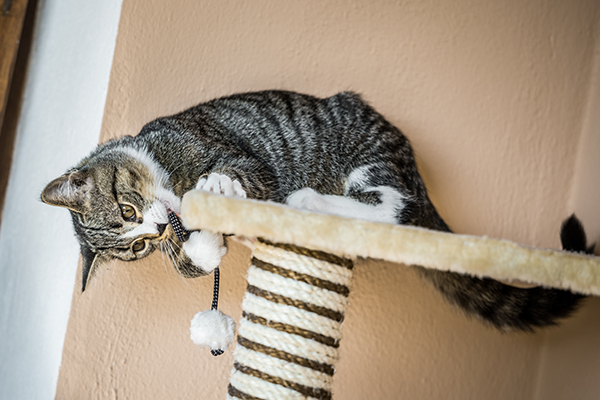Is your cat engaging in inappropriate scratching behaviors? Here’s how to train your cat to scratch appropriately — and love his scratcher.
1. Give a scratcher they prefer

Offer appealing scratching items to redirect your cat’s need to scratch. There are many types of scratching posts and pads available, and observing how your cat uses his claws will help you choose the right style. If your cat is a rug scratcher, a flat horizontal scratching pad or box works best. Cats who like to claw on sofas tend to prefer a vertical scratching post.
Offer your cat a variety of types and textures, so he won’t get bored with just one. Scratchers let your cat flex his paws and keep his nails filed, while keeping him away from your rug and furniture.
2. Pick the right place
Put scratching pads around your home where your cat likes to hang out. A place central to the household’s action is ideal, especially if it’s a place where you tend to be. If you tuck scratching pads away from everyone, your cat won’t go out of his way to find and use them.
3. Encourage with treats
Put catnip on the scratcher, and lead your cat toward it with toys and treats. When he chooses the scratching post over your sofa, give him praise and a yummy treat to make it a memorable positive experience.
Should you find him scratching your sofa or carpet, gently guide him to the “good” scratching spots and give him a treat. Bribery works, and he’ll soon get the idea that he gets a reward when he uses the pads and posts instead of the sofa.
4. Playtime and love is important
Give your cat lots of love and playtime. Boredom can cause your cat to create his own excitement by attacking your furniture, enabling him to release his pent-up energy at the expense of your décor. Play with your cat daily to tire him out, so he won’t redecorate your house with his claws.
Thumbnail: Photography ©marima-design | Thinkstock.
Rita Reimers’ Cat Behavior Coaching has helped many cat owners better understand their feline friends. Visit RitaReimers.com to read her cat behavior blog or to book a cat behavior coaching session. Rita is also the CEO/owner of JustForCatsPetsitting.com. Connect with her on Facebook and on Twitter.
Editor’s note: This article appeared in Kittens, a special issue from Catster magazine. Look for Kittens on a newsstand near you!








